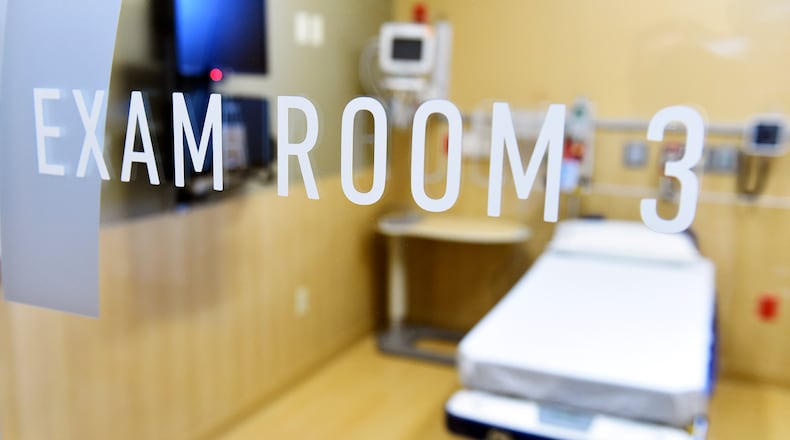HOW TO GET HELP: An opioid addiction resource guide
The report also detailed other emotional and behavioral health needs, including the need for more access to services and workers, trauma-informed care and evidence-based programs implemented in schools.
Reem Aly, primary author of the report, said the research shows the importance of a comprehensive approach to social and emotional health programs instead of a piecemeal approach.
“There is funding and there are programs in school that are evidence based. There is not a comprehensive policy approach,” Aly said.
Many of the health challenges adults in Ohio face today are rooted in experiences and conditions that could have been better addressed during childhood, according to Health Policy Institute of Ohio.
These missed opportunities to improve childhood health lead to less healthy lives and higher spending for adults in Ohio. In one example, the report said children who grow up without access to healthy food risk diabetes and heart disease as adults.
MORE: ‘We’re making a difference’: A day with Dayton’s overdose response team
Shannon Jones, executive director of early childhood policy group Groundwork Ohio, said the report shows that only 20 percent of childhood health is affected by what happens in a clinical setting and the other 80 percent depends on other factors. She said the state needs to start evaluating policy through that lens.
“We’ve got some big challenges that we have to focus on and this helps provide a road map for policy makers,” Jones said.
The top priorities the report said need to be addressed are mental health and addiction, chronic disease and maternal and infant health.
Deborah Feldman, CEO of Dayton Children’s Hospital, presented on these issues Thursday in Columbus as part of the Vote for Ohio Kids Campaign, created by Groundwork Ohio and the Ohio Children’s Hospital Association.
Feldman said political candidates should make it a policy priority to address the top health issues children face, which are not only affected by clinical care but also other issues outside the hospital.
RELATED: ‘A whole new life:’ Local people share their path out of addiction and into long-term recovery
“We believe it begins with addressing those child health issues that really are beyond the walls sometimes of our hospitals,” Feldman said.
Some of the reports recommendations to policy makers include universal K-12 school based prevention programs for suicide awareness, violence prevention and social and emotional health.
To address behavioral health care gaps, higher education financial incentives for health professionals serving underserved areas were among the recommendations. The report also called for universal evidence-based behavioral health services in schools, which could include school-linked health centers.
Chronic disease rates and infant death rates were both high and contained sharp racial disparities. Black children were 4.3 times more likely to go to the ER related to asthma compared to white peers in 2016. Also in 2016, Ohio’s black infant mortality rate of 15.2 infant deaths per 1,000 live births was almost three times as high as the white rate of 5.8 infant deaths per 1,000 live births. Black women in Ohio are also less likely to receive prenatal care during their first trimester of pregnancy and are more likely to deliver their baby preterm than white women.
For the widespread issue of childhood asthma, home visiting program workers could work with families to reduce home asthma triggers and educate on ways to manage asthma. Children with asthma could also be aided by better access to asthma medication and home improvement loans and grants to reduce asthma triggers at home.
More infants could be helped by evidence-based programs that support pregnant women and improve access to prenatal care, such as CenteringPregnancy. There’s also room to remove administrative and logistical barriers for women who want to access long-acting reversible contraception immediately after giving birth, with helps promote a safe space of time between pregnancies and improve birth outcomes.
The report also called for children to have a medical home, which is a model of primary care centered around on an ongoing relationship between the patient and provider.
MORE: Doctor billing lawsuit expands, now includes Kettering Health
Gregory Hopkins, executive director of Community Health Centers of Greater Dayton, said it can be easier to episodically go to an urgent care or some other convenient type of health care, but there’s a health benefit when children are taken to a medical home with a regular provider. The medical home can connect the children to other services from dental to behavioral health.
“That relationship with that primary care provider is important. They get to know you. They know your history. There’s a higher probability you’ll make a point to schedule that appointment,” Hopkins said.
Children’s Health Facts & Figures
• From 2007 to 2017, suicide deaths for Ohio children increased for ages 8-17 from 35 deaths to 80 deaths and grew for ages 18-25 from 155 to 225 deaths. The youngest suicide victim was age 8.
• ADHD medications were the most commonly prescribed drug for all Ohio Medicaid enrollees ages 0-17. Medicaid spent nearly $120 million on ADHD medications in 2017, about six times more than the next highest cost drug.
• Ohio children have more hospital admissions for asthma than children in most other states. Black children are 4.3 times more likely to have an asthma-related ER visit compared to white peers in 2016.
• In 2016, 36 states had a higher percentage of children reporting a healthy weight compared to Ohio.
• One fifth of children in Ohio lived in a household where there was uncertainty of having enough food or an inability to acquire enough food for all household members from 2013 to 2015.
Source: Health Policy Institute of Ohio
Unmatched coverage
Children’s issues highlighted in the report were at the center of a Columbus forum Thursday where Democrat Richard Cordray and Republican Mike DeWine talked about children’s early education and health at a gathering of some 700 business, education and health care leaders.
About the Author
